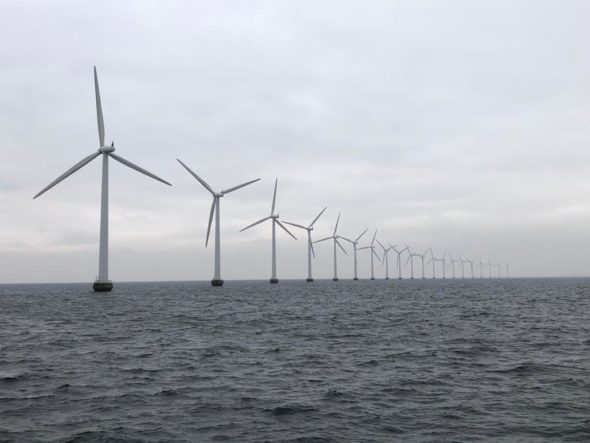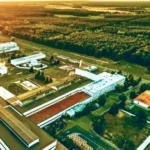Over a week ago, the Polish government adopted a resolution on building an installation harbor for offshore wind farms in the Port of Gdynia. The port management hopes that the final installation terminal in the outer harbor will be ready in 2026, and that until then, as an interim solution, the offshore wind farm construction will be supported from an inner harbor, so that services can be made available to developers in two-three years. So what needs to be done in the inner harbor? Logistics and planning the navigation around the port will be crucial, but these challenges may cause problems for traffic management and unloading – writes Bartłomiej Sawicki, editor at BiznesAlert.pl.
Navigation analysis – jack-up with problems
The Navigational Analysis for the Port of Gdynia published in June, stated that it is possible to reload offshore wind farm elements with the use of jack-up vessels by the Helskie I and Bułgarskie Quays, together with the option of entry/exit to the port and maneuvers in the harbor. The biggest limitation to this option is the width of the pilot, i.e. the inner entry to the port (140 meters) and the width of the main entrance (150 meters).
According to the conclusions included in the analysis, in case jack-up vessels are used (the most popular type), it will be necessary to verify and calculate the point load on the seabed exerted by the legs of the vessel during the loading of the wind turbine elements, with consideration to maintaining the stability of the neighboring quays. „The required minimum one-way lane for a jack-up vessel with a total width of 60 m (without a transverse load) is 174 m. The required minimum one-way lane for a jack-up vessel with a total width of 115.5 m (with a load) is 335 m,” the analysis said. This means it will be hard to place such a construction in the existing port infrastructure.
This is because it is impossible to move a jack-up vessel from the Bułgarskie Quay when a ship is docked at the Helskie I Quay. The only time when a loaded jack-up vessel could exit the Bułgarskie Quay/ the corner with the Puckie Quay is when, e.g. there are no ships at the Helskie I and Bułgarskie Quay and when the ships are skilfully moved around and navigated around the dock. In other words, the idea is to avoid „traffic jams” in the inner port. The Port of Gdynia wants to keep its main source of income, which is the transhipment of containers, and at the same time provide services to offshore wind farm developers.
Another big hindrance is the width of the pilot entry – 140 m (target width) and the main entrance to the port – 150 m. „Transporting a load (blades) that is 115.5 m long across the hull will cause a situation where the side distance to the navigation lighthouses will be 12.5 m in the pilot entrance and 17.25 m in the main entrance respectively, which may make maneuvers of the loaded ship risky. The problem with the potential risk of hitting the tips of the blades could be avoided if we could a get a ship that is capable of transporting a load at the right level,” the port said.
A resolution on the offshore port has been adopted. But without any dates or financing
The Gdynia Port Authority has stressed that the resolution, adopted over a week ago, despite being very general, does offer the long-awaited directions. It will also require more details, because the draft bill does not include any dates, financing, or particulars on the project itself. The management believes that the fact that the resolution is so general means the Ministry of Infrastructure wants the Port Authority to hammer out the details, at they have the necessary hands-on knowledge. However, considering the cost of the investment, the project will require a number of corporate decisions that will need to be approved by the company’s different bodies.
First a temporary port, then the final harbor
However, it needs to be stressed that already at this moment if the construction and assembly of offshore wind farms starts in 2024, the Port of Gdynia will not make it to build an outer installation port for offshore projects with two berths for installation ships. This is the target investment for offshore wind farms. The year 2024 is of key importance, because that is when the installation of offshore wind farms will start. „The terminal in the outer port, which is being planned, may be ready in 2025/2026 at the earliest, provided we will take some of the necessary steps in the coming weeks. If not, the opening of the new harbor will be postponed to later and later dates,” Maciej Krzesiński, the Outer Port Gdynia Project Manager, told us.
Therefore, the port managers stress that the installation terminal for offshore may be built in the inner port, which already exists. „We are able to modernize the port facilities and coordinate the movement of ships, so that the terminal in the inner port could handle projects already in 2024. Of course, this is just an interim solution, which can handle a small, single project, or an initial phase of a bigger one. It is also characterized by the relatively small, but still hefty effort and cost. However, it needs to be clearly stated that it will be impossible to implement Polish offshore wind projects that will generate between a few and several GW, without an outer port. Currently we do not have the space, the technical and navigational capabilities that make it possible to efficiently handle constructions that are that big. Either way, no Polish harbor has such capabilities at this point. This is why it is necessary to build dedicated infrastructure,” Krzesiński explained in an interview with BinesAlert.pl. Offshore as a loading group is very characteristic, because it needs many stacking yards and requires that unusual and very heavy loads are handled. The idea behind the harbor is to build a dedicated offshore terminal, which has been in design for the past 2-3 years. „It meets all the requirements that the industry has put forward and more. The place will be capable of handling two investments simultaneously, and two jack-ups that will not interfere with one another,” the port manager ensured.
The port management has stressed that an outer port will be necessary. When will the final terminal be ready? „If we started building the installation, outer, port today, and I need to stress the we already have the majority of the documents ready, it would be ready in about five years,” Krzesiński explained. However, at this point no decisions to this effect have been made.
What needs to be done in the inner port?
The inner port needs to be modernized and adapted to the needs of the industry. This mostly pertains to the access routes that connect the quays with the stacking yards behind the Kwiatkowski Flyover, which will make it possible to easily move with the load. The bed of the quays also needs to be modernized. It is also necessary to purchase the right lifting equipment. „The infrastructure we have, once modernized, will make it possible to handle the first elements of the offshore wind farms during the first and second year. So, it will be just an interim port, it will function on the basis of what we already have. Considering the scale of how offshore wind farms are developing, it will not be possible to handle installations that will produce between a few and several GW, without an outer port,” Krzesiński said.
The biggest challenge are installations ships with blades, as they are usually positioned across a ship’s diametrical axis. Considering the length of the biggest blades (between 107 and 117 m) that are offered by the largest producers, the handling of such vessels without additional upgrades and traffic plan may lead to collisions, or prove to be impossible from an operational point of view. Whereas the jack-ups may dock at the inner port, but only when certain requirements are met. The entrance or exit of such a vessel is also limited by a number of restraints. So, the requirements are in reality quite complicated. „Currently we are talking to the Maritime Office and other interested parties on how to manage this. The priority of the Port of Gdynia is to maintain its liner services, because that is its main source of income. The Helskie Quay, which we want to use for the installation port in the inner harbor, is generally used today by the container terminal,” the port representative said. So, the Navigational Analysis does not exclude the handling of offshore in this area of the port, provided that a strict work and maritime traffic regime is kept.
What conclusions can be drawn from the available information? For the Port of Gdynia to be able to handle as many installations as possible, it will be necessary to modernize the facilities, a process that will start already this year. In 2024 three developers may start building offshore wind farms. Despite the lack of certainty that the inner port will be technically and logistically ready in three years, the developers will start tenders already this year.









